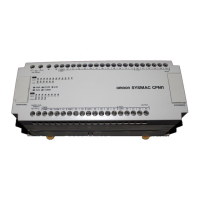208
JUMP and JUMP END – JMP(04) and JME(05) Section 5-12
instructions in between. The status of timers, counters, bits used in OUT, bits
used in OUT NOT, and all other status bits controlled by the instructions
between JMP(04) and JMP(05) will not be changed. Each of these jump num-
bers can be used to define only one jump. Because all of instructions between
JMP(04) and JME(05) are skipped, jump numbers 01 through 99 (01 through
49 in CPM1/ CPM1A/SRM1 PCs) can be used to reduce cycle time.
Jump Number 00
If the jump number for JMP(04) is 00, the CPU Unit will look for the next
JME(05) with a jump number of 00. To do so, it must search through the pro-
gram, causing a longer cycle time (when the execution condition is OFF) than
for other jumps.
The status of timers, counters, bits used in OUT, bits used in OUT NOT, and
all other status controlled by the instructions between JMP(04) 00 and
JMP(05) 00 will not be changed. jump number 00 can be used as many times
as desired. A jump from JMP(04) 00 will always go to the next JME(05) 00 in
the program. It is thus possible to use JMP(04) 00 consecutively and match
them all with the same JME(05) 00. It makes no sense, however, to use
JME(05) 00 consecutively, because all jumps made to them will end at the first
JME(05) 00.
DIFU(13) and DIFD(14) in
Jumps
Although DIFU(13) and DIFD(14) are designed to turn ON the designated bit
for one cycle, they will not necessarily do so when written between JMP(04)
and JMP (05). Once either DIFU(13) or DIFD(14) has turned ON a bit, it will
remain ON until the next time DIFU(13) or DIFD(14) is executed again. In nor-
mal programming, this means the next cycle. In a jump, this means the next
time the jump from JMP(04) to JME(05) is not made, i.e., if a bit is turned ON
by DIFU(13) or DIFD(14) and then a jump is made in the next cycle so that
DIFU(13) or DIFD(14) are skipped, the designated bit will remain ON until the
next time the execution condition for the JMP(04) controlling the jump is ON.
Precautions When JMP(04) and JME(05) are not used in pairs, an error message will
appear when the program check is performed. This message also appears if
JMP(04) 00 and JME(05) 00 are not used in pairs, but the program will exe-
cute properly as written.
Flags There are no flags affected by these instructions.
Examples Examples of jump programs are provided in 4-3-9 Jumps.

